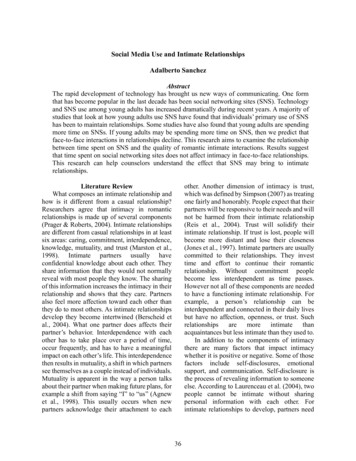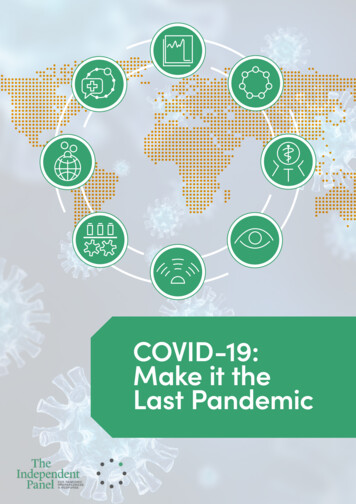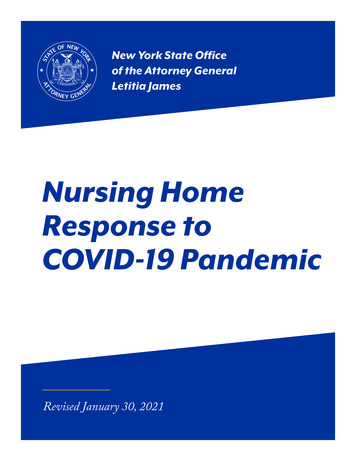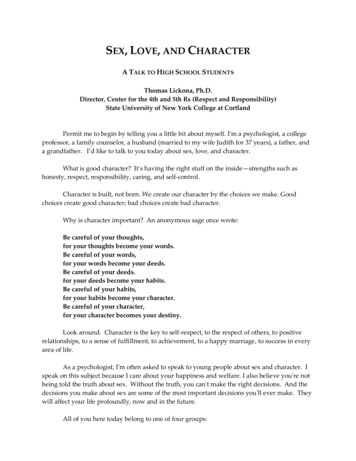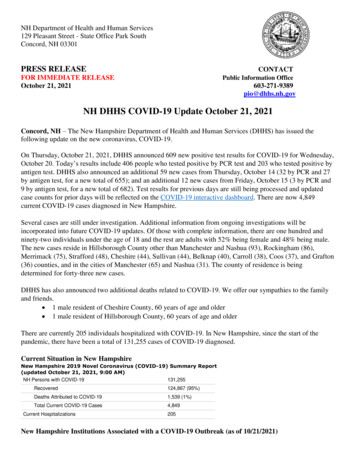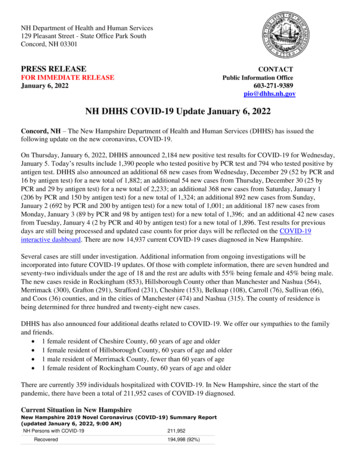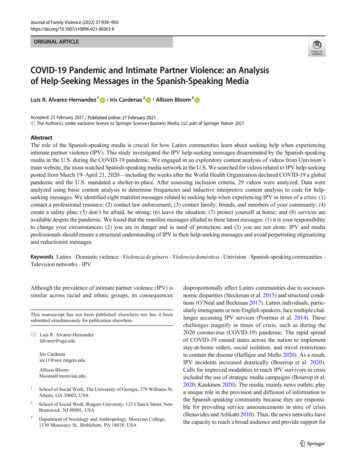
Transcription
Journal of Family Violence (2022) 63-8ORIGINAL ARTICLECOVID-19 Pandemic and Intimate Partner Violence: an Analysisof Help-Seeking Messages in the Spanish-Speaking MediaLuis R. Alvarez-Hernandez 1&Iris Cardenas 2&Allison Bloom 3Accepted: 23 February 2021 / Published online: 27 February 2021# The Author(s), under exclusive licence to Springer Science Business Media, LLC part of Springer Nature 2021AbstractThe role of the Spanish-speaking media is crucial for how Latinx communities learn about seeking help when experiencingintimate partner violence (IPV). This study investigated the IPV help-seeking messages disseminated by the Spanish-speakingmedia in the U.S. during the COVID-19 pandemic. We engaged in an exploratory content analysis of videos from Univision’smain website, the most-watched Spanish-speaking media network in the U.S. We searched for videos related to IPV help-seekingposted from March 19–April 21, 2020—including the weeks after the World Health Organization declared COVID-19 a globalpandemic and the U.S. mandated a shelter-in-place. After assessing inclusion criteria, 29 videos were analyzed. Data wereanalyzed using basic content analysis to determine frequencies and inductive interpretive content analysis to code for helpseeking messages. We identified eight manifest messages related to seeking help when experiencing IPV in times of a crisis: (1)contact a professional resource; (2) contact law enforcement; (3) contact family, friends, and members of your community; (4)create a safety plan; (5) don’t be afraid, be strong; (6) leave the situation; (7) protect yourself at home; and (8) services areavailable despite the pandemic. We found that the manifest messages alluded to three latent messages: (1) it is your responsibilityto change your circumstances; (2) you are in danger and in need of protection; and (3) you are not alone. IPV and mediaprofessionals should ensure a structural understanding of IPV in their help-seeking messages and avoid perpetrating stigmatizingand reductionist messages.Keywords Latinx . Domestic violence . Violencia de género . Violencia doméstica . Univision . Spanish-speaking communities .Television networks . IPVAlthough the prevalence of intimate partner violence (IPV) issimilar across racial and ethnic groups, its consequencesThis manuscript has not been published elsewhere nor has it beensubmitted simultaneously for publication elsewhere.* Luis R. Alvarez-Hernandezlalvarez@uga.eduIris Cardenasiec11@ssw.rutgers.eduAllison Bloomblooma@moravian.edu1School of Social Work, The University of Georgia, 279 Williams St,Athens, GA 30602, USA2School of Social Work, Rutgers University, 123 Church Street, NewBrunswick, NJ 08901, USA3Department of Sociology and Anthropology, Moravian College,1130 Monocacy St., Bethlehem, PA 18018, USAdisproportionally affect Latinx communities due to socioeconomic disparities (Stockman et al. 2015) and structural conditions (O’Neal and Beckman 2017). Latinx individuals, particularly immigrants or non-English speakers, face multiple challenges accessing IPV services (Postmus et al. 2014). Thesechallenges magnify in times of crisis, such as during the2020 coronavirus (COVID-19) pandemic. The rapid spreadof COVID-19 caused states across the nation to implementstay-at-home orders, social isolation, and travel restrictionsto contain the disease (Haffajee and Mello 2020). As a result,IPV incidents increased drastically (Boserup et al. 2020).Calls for improved modalities to reach IPV survivors in crisisincluded the use of strategic media campaigns (Boserup et al.2020; Kaukinen 2020). The media, mainly news outlets, playa unique role in the provision and diffusion of information tothe Spanish-speaking community because they are responsible for providing service announcements in time of crisis(Benavides and Arlikatti 2010). Thus, the news networks havethe capacity to reach a broad audience and provide support for
940Latinx IPV survivors. However, the role of the Spanish language media in delivering information to those experiencingIPV in times of national crises has not yet been explored. Toaddress this gap, our study examined the IPV help-seekingmessages shared through the Spanish-speaking media duringthe COVID-19 pandemic.To achieve the purpose of our study, we used Univision’smain website to collect Spanish-language news videos relatedto IPV and COVID-19 and qualitative methods to analyze thedata. Specifically, we used content analysis to identify thehelp-seeking messages and thematic analysis to analyze suchmessages. Our study aimed to explore the IPV help-seekingmessages that the Spanish-speaking media disseminated during a health crisis to improve current efforts to address IPV inthe Spanish-speaking community.IPV Help-SeekingLike in the general population, IPV is prevalent in the Latinxcommunity. About 34% of Latinx women and 30% of Latinxmen experience IPV at some point in their lives (Smith et al.2017). IPV may lead to developing physical and mental healthproblems (Jordan et al. 2010; Loxton et al. 2017), which areespecially detrimental for Latinx individuals due to existinginequities. For example, Bonomi et al. (2009) found thatLatina IPV survivors have higher rates of poor physical andmental health than non-Latina IPV survivors. Therefore, service utilization is paramount to improve IPV survivors’ wellbeing and reduce re-victimization (Marrs Fuchsel andBrummett 2020; Trabold et al. 2020). Nevertheless, Latinxindividuals face multiple barriers to accessing services dueto systemic oppression, forcing them to stay in violent relationships (Postmus et al. 2014). For example, immigrantLatinx individuals may fear police involvement based on mistreatment experiences, discrimination, or anti-immigrationsentiment in the U. S. (Becerra et al. 2017). Fear of deportationexacerbated during the Trump administration (Hing 2018)deters many others from obtaining assistance (Rizo andMacy 2011). Additionally, a lack of English-language proficiency and service availability or unawareness of resourcespose further challenges to Latinx individuals (Rizo andMacy 2011; Robinson et al. 2020). Liang et al. (2005) proposed a theoretical framework to better understand the factorsinfluencing a survivor’s decision to seek help for IPV.The Help-Seeking ProcessLiang et al.’ (2005) framework focuses on IPV survivors’cognitive process leading to the intentional action of lookingfor help. This framework incorporates the influence of individual, interpersonal, and sociocultural factors, emphasizingJ Fam Viol (2022) 37:939–950that the help-seeking process is iterative, in which feedbackloops are ongoing. According to Liang et al. (2005), the helpseeking process consists of three steps: problem recognitionand definition, the decision to seek help, and selecting a helpprovider.The problem recognition and definition step in this modelentails the interpretation of abusive experiences as such.Individuals who are ready to make changes in their life mayrecognize abusive behaviors more readily. On the other hand,the lack of awareness about what constitutes violent behaviorsmight limit the recognition of IPV as a problem (Liang et al.2005). One way in which the recognition of abusive behaviorscan be influenced is through its portrayal in the media (Carlyle2017). The second step in the help-seeking process model,deciding to seek help, depends on two cognitive processes.One process is the abusive behaviors becoming undesirable,and the second process is acknowledging the violence is likelyto continue without external help.The last step of the help-seeking process refers to the identification of a source of support. After abusive behaviors arerecognized and individuals decide to seek help, they determine where and from whom to ask for help, often engagingin a benefit analysis. Determining whether seeking help isfeasible and beneficial depends in part on the availabilityand awareness of resources, which influences the selectionof service providers. Because of the news outlets’ broad reach,they are well-positioned to promote information related to IPVservices and assist individuals during their help-seeking process (Carlyle et al. 2014).Media and IPVMedia influences the perception of social problems (Carlyle2017) and serves to provide education and information(Benavides and Arlikatti 2010). News broadcasting can influence the help-seeking process by shaping the identification ofbehaviors within a partnership as abusive, promoting awareness of available IPV resources, encouraging disclosure ofIPV, and fostering actions to seek assistance to leave a violentrelationship (Carlyle et al. 2014). With the growth of theSpanish language media (Benavides and Arlikatti 2010), thereis a greater opportunity to communicate with otherwise hardto reach Latinx IPV survivors.Although the Spanish language media produces similarcontent to English language news outlets, it is delivered withinthe Latinx context (Gomez-Aguinaga 2020). Unfortunately,assessments about the media messages communicated toLatinx Spanish-speaking IPV survivors seem to be limited.This lack of knowledge is disconcerting because a vast majority of Latinx individuals (68%) consume their news inSpanish, despite English language proficiency (Lopez andGonzález-Barrera 2013). The large percentage of Latinx
J Fam Viol (2022) 37:939–950people engaging in Spanish media consumption is not surprising since almost 38 million Latinx individuals speak Spanishat home, not counting unauthorized immigrants (HernándezNieto et al. 2017). The most popular platform for news in theLatinx community is the television (Lopez and GonzálezBarrera 2013). Univision’s network, a Spanish-language media company, has the largest nationwide Latinx viewership(Hernández-Nieto et al. 2017). In 2020, their network averaged 1.4 million viewers during primetime (UnivisionCommunications Inc. 2020a). Between the week ofMarch 16 and March 20, 2020, Univision’s audience totaled1.7 million, becoming the leading Latinx media company(Univision Communications Inc. 2020b). Despite this network’s extensive reach, little is known about the messagesthey provide to assist those experiencing IPV during a nationalcrisis such as the COVID-19 pandemic.COVID-19 and IPVThe measurements enacted to control the spread of COVID19 seem to have increased IPV incidents, particularly at residential locations (Boserup et al. 2020; McLay 2021). Socialisolation and stay-at-home orders meant that many IPV survivors were stuck at home with violent partners. These restrictions might have created more opportunities for control andabusive behaviors (Van Gelder et al. 2020). The closure ofbusinesses and schools and job losses added to the stress already experienced due to the pandemic, exacerbating the riskfor violence (Kaukinen 2020). Quarantine might have alsoincreased alcohol use (Brooks et al. 2020), which might be arisk factor for IPV (Foran and O'Leary 2008).Although the outbreak of COVID-19 was widespread,some states were more impacted than others. As of April13, 2020, only four weeks after the outbreak became apandemic (Cucinotta and Vanelli 2020), thirteen stateshad more than 10,000 confirmed cases of the novel coronavirus (Centers for Disease Control and Prevention[CDC] 2020). Instructions to stay at home were issuedto all of their residents (Mervosh et al. 2020). These statesincluded those with the largest Latinx populations (i.e.,California, Florida, Georgia, Illinois, New Jersey, NewYork, and Texas), accounting for 77% of the U.S.Latinx population (Hernández-Nieto et al. 2017). Thatis, the measurements implemented to curve the pandemicaffected at least 44 million Latinx individuals in the firstmonth since COVID-19 became a national emergency.With such a large number of Latinx individuals affectedby the stay-at-home orders, likely getting their newsthrough the Univision network, it is critical to identifywhat messages they received and determine whether thosemessages foster or hinder IPV help-seeking behaviors.941Current StudyAlthough the Spanish-speaking media plays a key role inLatinx communities, the messages they share about IPV, especially in times of crisis, are unknown. Thus, this study addresses this gap by exploring the IPV help-seeking messagesdisseminated by the Spanish-speaking media (i.e., Univision)in the U.S. during the most recent health crisis, COVID-19.The research question guiding this study was: What are theIPV help-seeking messages disseminated by the Spanishspeaking media in the U.S. during the COVID-19 pandemic?MethodologyTo answer the research question, we engaged in an exploratory content analysis of videos from Univision’s main website,the most-watched Spanish-speaking media network in theU.S. Content analysis is a systematic technique for developingcategories out of large amounts of data like documents, art,and videos (Stemler 2000). Hence, content analysis aids in theprocess of exploring and understanding the explicit and implicit messages present in media messages. Content analysishas been employed to understand health-related issues likeobesity (Yoo and Kim 2012) and Alzheimer’s disease (Tanget al. 2017). Moreover, content analysis has also been utilizedto analyze the portrayal of IPV in print media (Kelly andPayton 2018).Data CollectionWe collected data from Univision, the largest and mostwatched Spanish-speaking media outlet in the U.S. Hence,the videos resulting from the search were all in Spanish. Weutilized the search engine available on Univision’s mainwebsite (univision.com). The main website contains generalpublications made by Univision, as well as publications fromlocal Univision subsidiaries. First, we entered the keyword“violencia” (violence) because in Spanish many of the IPVterms incorporate this word, including violencia doméstica,violencia de género, violencia familiar, violenciaintrafamiliar, and violencia contra la mujer (domestic violence, gender-based violence, family violence, intrafamilialviolence, and violence against women). We conducted asearch for the “the last month” option in Univision’s searchengine—the most adequate preset timeframe alternative, given that the other options were “this week,” “this year,” and“any dates.” We conducted the search between April 19,2020, and April 21, 2020. Thus, “the last month” coveredMarch 19, 2020, to April 21, 2020. This timeframe includedthe week after World Health Organization (WHO) declaredCOVID-19 a global pandemic on March 11, and the weeksleading up to and following the federal mandate for shelter-in-
942place on March 29, 2020. Both of these events, COVID becoming a pandemic and shelter-in-place mandates, were critical for the increase of families staying at home with theirabusers. We also filtered the search for “articles” and “videos”as some articles contained embedded videos as well. A total of170 hits for articles and 160 hits for videos emerged from theinitial search.Second, the results were screened for terms related to IPV,including terms like violencia, abuso, abusiva, abusivo, andmaltrato (violence, abuse, abusive, and maltreatment) andwords related to the coronavirus, including terms likeCOVID-19, pandemia (pandemic), cuarentena (quarantine),and aislamiento (isolation) in either the title or description ofthe article or video. A total of 13 articles with embeddedvideos and 55 videos met the criteria for including both termsor their variations (n 68). We continued to add new keywords as we learned about the media’s verbiage to refer toIPV. This iterative process allowed us to understand howusers may be able to find the content.Third, we compared the articles and the videos and removed four duplicated videos (n 64). We then read the titlesand summaries and watched the videos to exclude content inwhich IPV was not the focus of the video (e.g., a video reported the cleaning of the offices of the domestic violence policeunit after concerns of some officers being exposed to COVID19) and about reports outside of the U.S. One researcherreviewed the results for articles, while another researcherreviewed the results for videos. Both researchers reviewedthe content of the videos that did not clearly fit the inclusioncriteria. A total of 32 videos met the criteria for inclusion inthis step. Finally, the two researchers screened the 32 resultsseparately to assess for meeting criteria for providing information on how or where to seek help (either formal or informal).Then, both researchers compared their inclusion lists. A totalof 29 videos met final inclusion for data analysis. Figure 1shows this process.Data AnalysisWe employed Drisko and Maschi’s (2016) guidelines for content analysis to identify the help-seeking messages and thenBraun and Clark’s (2006) framework for thematic analysis toanalyze the messages. We charted each video using Exceltables to document the following information: (1) title of thevideo; (2) length of the video; (3) date of publication, (4) linkto the video; (5) source (i.e., national or local news); (6) perceived gender of media staff; (7) perceived gender of the external person(s); (8) help-seeking messages (e.g., providestrategies, provide resources); (9) source of information(e.g., WHO, local expert); (10) if resources were provided,are they local, national, or both; (11) if resources were local,city and state of the resources; and (12) population addressed(i.e., who is the recipient of IPV). We then employed basicJ Fam Viol (2022) 37:939–950content analysis to determine frequencies for each of the identified sections. Basic content analysis serves as a tool to quantitatively “summarize or describe data” (Drisko and Maschi2016, p. 58).We also used inductive interpretive content analysis tocode for help-seeking messages delivered in the videos.Interpretive content analysis allows for inferring the explicitand implicit intention of a text, including verbal communication, based on context. According to Drisko and Maschi(2016), “[r]esearchers may use interpretive content analysisto describe content and meanings, to summarize large datasets, and to make inferences about intentions, thoughts, andfeelings based on speech or other forms of communication”(p. 65).We coded for both manifest (overt) and latent (covert)messages about IPV help-seeking. Manifest messages arethe literal messages of a statement, while latent messages arethe underlying or implied messages that emerge from the literal messages. We utilized Braun and Clarke’s (2006) stepsfor thematic analysis to generate codes and themes based onthe visual and spoken messages. The two researchers codedlatent messages separately and then compared them to increase validity and replicability. The two researchers agreedon most codes. Both the manifest and latent sets of codes wereexhaustive, exclusive, and enlightening (Rose 2016).TrustworthinessTrustworthiness in this study was sought by the use of reliability and the authors’ reflexivity about their own identities.Reliability After excluding videos that did not meet the criteriafor providing information on how or where to seek help, tworesearchers separately screened the videos that appeared tomeet the criteria (n 32). They then compared their inclusionlists. There was an 87% agreement between the two researchers on the inclusion of videos for the final sample,which is above the 80% agreement needed for reliability incontent analysis (Drisko and Maschi 2016). Disagreementswere discussed between both researchers, which led to a100% agreement on the selection of the final sample (n 29).Subjectivity Statements We recognize that the interpretationof the data is a construction based on our identities and experiences. The first author is a bilingual gay Latino with practiceand research experience in the area of Latinx mental health.As a clinical social worker, he has also participated in variousmedia interviews. His experiences influence how he evaluatesthe media messages in general and the discourse of the reporters and experts in particular. The second author is a bilingual immigrant Latina researching IPV among Latinas. Shehas practical social work experience with immigrant communities. These experiences inform her approach to the media
J Fam Viol (2022) 37:939–950943Fig. 1 Data Collection Proceduremessages directed to the immigrant and Latinx populations.The third author is a cultural anthropologist who has workedin the IPV field as a practitioner and researcher for over adecade. As a white, cisgender woman, her experiences andapproach to data analysis are informed by this identity, as wellas her work specifically in Latin America and working withLatinx communities in the U.S.ResultsDescriptive Information of VideosThe 29 videos were posted between March 23, 2020, andApril 17, 2020. The length of the videos was between27 seconds and almost seven minutes. Most videos(59%) were between two and three minutes long. Of the29 videos, 24 (83%) were posted by local subsidiaries ofUnivision. Nine videos were from Texas (Dallas-FortWorth, Houston, and San Antonio), five from California(Bay Area, Fresno, Los Angeles, and Sacramento), andfour from Illinois (Chicago). Other subsidiaries that published one video each included Georgia (Atlanta),Pennsylvania (Philadelphia), Arizona, North Carolina,New York, and Florida (Miami-Ft. Lauderdale). Most reporters were perceived to be men (59%), while most interviewees were perceived as women (66%). Table 1 contains descriptive information for each video.IPV InformationReporters employed the use of interviewees or resources forthe information provided in 27 out of the 29 videos.Moreover, 15 videos cited only one source, 10 videos citedtwo sources, and two videos cited three sources. Local experts(e.g., counselors and staff at shelters) were the most utilizedsources for IPV information (21 occasions), followed by lawenforcement and judicial staff (10 occasions). Other sources ofinformation regarding IPV included statements by the UnitedNations, IPV survivors, staff from national domestic violenceorganizations, and other government staff. A total of 21 videos(72%) included background dramatization videos or imagesdepicting IPV situations. All of these 21 videos and imagesdepicted women as recipients of physical violence.Help-Seeking ResourcesA total of 25 videos provided information about resourceswhere individuals could seek help for IPV (86%). However,some of the videos mentioned the name of the resources butdid not provide their contact information or vice versa. Hence,we had to do an online search on multiple occasions to link thename and location of resources with the contact informationprovided and vice versa. Information about local resourceswas provided 62% of the time, while national resources werementioned 38% of the time. A total of four videos did notprovide information about resources. Of the 29 videos, 11
944J Fam Viol (2022) 37:939–950Table 1Descriptive Information of VideosLocation of(n Length of Date ofPublication the Video29) Video(mins:secs)PerceivedGender ofMediaStaffPerceivedGender 3:152:2027 s50 anWomanWomanWomanWoman252652 3/31/20203/23/2020SanAntonioSacramentoBay AntonioNorthCarolinaNew 2020NationalManWomanvideos provided the national domestic violence hotline’s contact information, and five videos asked survivors to call 911.Help-Seeking MessagesManifest and latent codes were identified in the data. Manifestcodes were the literal messages disseminated across the videosabout IPV help-seeking. Latent codes were the underlyingmessages of what IPV help-seeking means. Table 2 displaysmore information about these messages and examples ofrelated quotes. The quotes are provided in the English translation, followed by the original statements in Spanish in italicsand inside parenthesis. In some examples, contextual information has been provided inside brackets.Manifest Messages Eight manifest messages emerged for howto seek help when experiencing IPV during the COVID-19crisis. None of the videos communicated all of the eight manifest messages, although multiple messages were disseminated per video. The eight manifest themes were: (1) contact aprofessional resource (n 20); (2) contact law enforcement(n 11); (3) contact family, friends, and members of yourcommunity (n 9); (4) create a safety plan (n 6); (5) don’tbe afraid, be strong (n 9); (6) leave the situation (n 5); (7)protect yourself at home (n 5); and (8) services are availabledespite the pandemic (n 5). Messages regarding contacting aprofessional resource suggested viewers reached out to localagencies (their contact information was often shared in thevideo) and the national help-line. Contacting law enforcementwas mentioned in the context of safety, asking viewers to call9–1-1, the local police departments, or the courts. Safety planning included suggestions like gathering important documents, making an emergency bag, and memorizing importantnumbers. The message of “don’t be afraid, be strong”encompassed comments like “If you are a victim, don’t beafraid” (“Si es víctima, no tenga temor”) and “A woman isstrong inside and do not stay silent” (“La mujer es fuerte pordentro y no se queden calladas”). Leaving the situation wasencouraged in times where the victim felt their life was indanger. These manifest messages could be collapsed into threeunderlying messages directed towards IPV help-seeking during the pandemic.Latent Messages Eleven broader latent messages emergedinitially. We then reviewed these themes and collapsedoverlapping themes, leading to a total of three themes:(1) you are not alone; (2) you are in danger and in needof protection; and (3) it is your responsibility to changeyour circumstances. Table 2 displays more informationabout these themes and their relationship with the eightmanifest themes. The first latent message, “you are notalone,” is related to the following manifest messages:contact a professional resource; contact family, friends,and members of your community; and services areavailable despite the pandemic. An example of this latent message can be seen when a staff member from alocal domestic violence agency encouraged viewers tocontact them as a professional resource,Depending on the situation and the case, we can referthem to the resources they need and give them information. The services are completely free, and we are not
J Fam Viol (2022) 37:939–950Table 2945Latent and Manifest Themes Regarding IPV Help-SeekingLatent ThemesManifest ThemesMessagesYou are not aloneContact aprofessionalresourceContact a professional resource either local or nationalA staff member from a local domestic violence agency inresources, via text, chat, email, or phone call. Resources areChicago stated: “Depending on the situation and the case,free, anonymous, and bilingual. Victims, perpetrators, andwe can refer them to the resources they need and give themothers who know about an IPV situation can call. They caninformation. The services are completely free and we arehelp with providing information and resources and withnot asking for any of their specific information. Everythingcreating a plan.is confidential.”(“Dependiendo de la situación y el caso podemos referirlos alos recursos que necesitan y darles la información. Losservicios son completamente gratuitos y no estamospidiendo ninguna información específica de ellos. Todo escompletamente confidencial.”)Contact family, friends, and members of your community,The chief of police from Houston stated: “Report the domesticincluding nearby businesses and neighbors. Keep themviolence. Go to a business, to a house, to a friend’s place.”informed about your situation and ask for their help.(“Reporte la violencia doméstica. Vaya a un negocio, vaya auna casa, vaya al lugar de un amigo.”)The courts are still open for IPV cases. Already establishedA reporter located in Miami stated: “The courts have put inrestriction orders are still valid and people are able to obtainmotion some special measures. Some courts, for example,new ones. Counseling and shelters are still available. Manyhave decided to extend the protection orders. Other judgesservices are available via email or phone.are even doing virtual hearings using video cameras to seeurgent cases.”(“Los tribunales han puesto en marcha algunas medidasespeciales. Algunos tribunales, por ejemplo, han decididoextender las órdenes de restricción y de protección. Otrosjueces están incluso recurriendo a audiencias virtualesutilizando videocámaras para atender casos deurgencias.”)It is essential to report the violence to law enforcement.A local police officer from Houston stated: “But the first thingContact law enforcement, including the courts, police, and[is that] they have to call Houston’s police department to911. Call if you feel you are at risk or unsure of what to do.report what is happening.”Others who know about an IPV situation can also report it. (“Pero lo primero [es que] ellos tienen que llamar aldepartamento de la policía de Houston para reportar loque está pasando.”)Leave the situation when the physical violence is stro
Although the Spanish-speaking media plays a key role in Latinx communities, the messages they share about IPV, es-pecially in times of crisis, are unknown. Thus, this study ad-dresses this gap by exploring the IPV help-seeking messages disseminated by the Spanish-speaking media (i.e., Univision)
